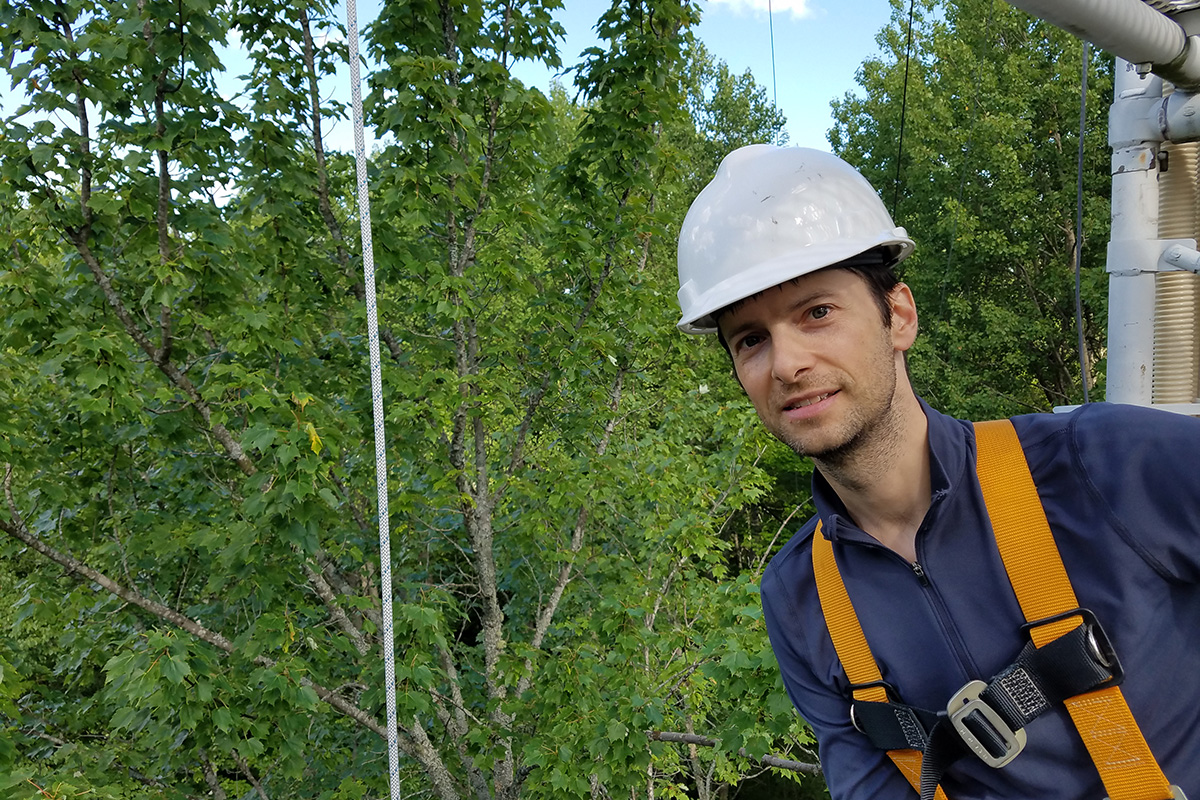Atmospheric Chemist Using NOAA Grant to Measure New Sources of Increased Ozone Production
By Tom Durso
 Associate Professor of Chemistry Ezra Wood, PhD, captured midway up a sampling tower at a measurement site in a forest.
Associate Professor of Chemistry Ezra Wood, PhD, captured midway up a sampling tower at a measurement site in a forest.
December 15, 2021
Thanks in large part to cleaner cars, ground-level ozone – which has harmful environmental and health impacts – has been declining in U.S. cities for decades.
That’s the good news.
The bad news is, ozone in the air of many cities remains high, and scientists aren’t sure why.
Armed with a $174,000 grant from the National Oceanographic and Atmospheric Administration (NOAA), Drexel’s Ezra Wood, PhD, is helping to find out.
Wood, an associate professor of chemistry, is the principal investigator of a project to characterize ozone formation in New York City. Ground-level ozone is formed when nitrogen oxides and volatile organic compounds (VOCs) mix during sunny days. As cars have gotten cleaner and emit smaller amounts of VOCs, volatile chemical products (VCPs), which come from coatings, adhesives, personal care products and cleaning agents rather than combustion sources, are emerging as a major source of VOCs in urban atmospheres.
“My group has instruments that can quantify not just ozone concentrations, but the chemical rate at which ozone is being created,” Wood says. “Our collaborators will have a lot of really good measurements of these volatile chemical products. Together we’ll see if there’s a connection between the amount of VCPs in the air and how fast ozone is formed.”
Wood and his team are deploying sensors at the CUNY Advanced Science Research Center in upper Manhattan, joining the NOAA-funded New York City Measurements of Emissions and TransformationS (NYC-METS) project, which is characterizing the emissions and transformations of non-traditional organic compounds in New York. He notes that similar studies in London and Beijing revealed that existing models were underestimating the amount of ozone creation.
“We'll see if that’s happening in New York as well,” Wood says.
Wood’s findings will get folded into those of numerous other related projects happening simultaneously. He and his colleagues will write and submit papers, with changes in public policy a potential end result.
“We’ve been studying urban air pollution since Los Angeles in the 1950s. And some things have changed,” Wood says. “The tools we have to measure what's in the air have gotten much, much better. We have very sophisticated scientific instruments that measure the concentrations of compounds A, B and C that we just could not do at all or couldn't do as well even just 10, 20, 30 years ago.”
And with combustion engines – such as those found in cars and trucks – emitting fewer VOCs, the question turns to VCPs. And cities are especially prone.
“If you can smell someone else – their cologne or perfume or deodorant, their clean hair or clothes – that means there are VCPs in the air,” Wood says. “It probably seems like really small amounts, but it all adds up, especially when you have a high population density.”